人教版高二英语选修6《Unit4 Global warming warming》导学案
- 格式:doc
- 大小:57.50 KB
- 文档页数:2
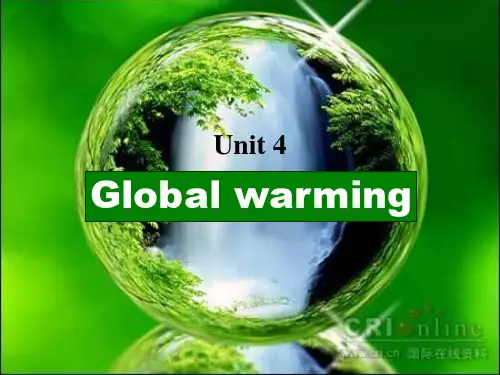
![新人教选修6-Unit4-Global-warming-Reading[阅读课件]](https://uimg.taocdn.com/3868ab45bceb19e8b9f6ba87.webp)

![人教新课标选修六 Unit 4 Global warming-Warming up & Reading[课件]](https://uimg.taocdn.com/e08569f3f61fb7360b4c654d.webp)
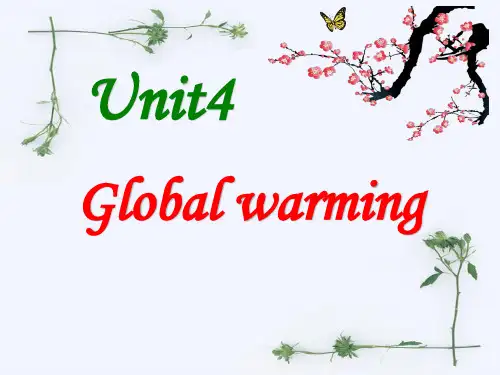
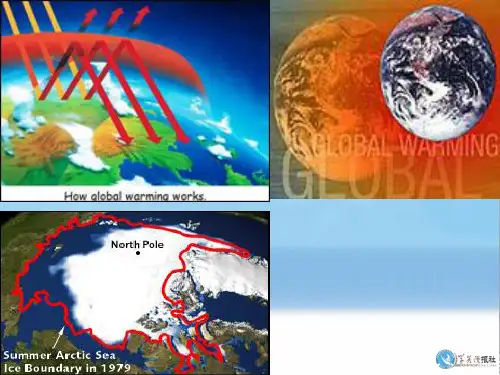

Book6 Unit4 Global warming 导学案(Period One: Reading)课前案Skim the text and finish the following information.1.What’s the main topic of the passage?The main topic of the passage is about .2.Who wrote the magazine article? What is the name of the magazine?wrote the magazine article; the name of the magazine is .3.What are the names of the three scientists mentioned in the article?The names of the three scientists mentioned in the article are , , and .Do they agree with one another? .4.The passage can be divided into three sections, match them with the main idea of each section.Part1.(1) A. How global warming comes aboutPart2. (2-5) B. List two different attitudes towards global warmingPart3. (6) C. Introduction of global warmingPart4. (7) D. Whether people should do something about global warming课中案学习目标:1.To learn some important words and phrases about global warming.2.To develop the reading skills by skimming and scanning the passage.3.To strengthen the awareness of environment protection .Step 1 Fast readingRead the text quickly and choose the best answers.1. How much did the temperature rise in the 1900s?A.One degree Fahrenheit. B.One Celsius.C.Two degrees. D.Thirty degrees Celsius.2.What causes the earth’s temperature increasing?A. Cutting treesB. Wasting the farmland.C. Running out of the river waterD. Burning fossil fuels.3.Which of the following is Dr. Janice F oster’s opinion?A. The result of the temperature increase will be serious.B. The amount of warming is nothing serious.C. We needn’t worry about high levels of carbon dioxide.D. Global warming is a natural phenomenon.4.According to George Hambley, .A. Global warming is a serious problem.B. There is no need to worry about global warming.C. The levels of CO2 in the air will become lower in the future.D. More animals will make greenhouse gases decrease.5. We can infer from the text that __________.A. the debate about the effects of global warming has not been settled.B. the greenhouse effect is the result of people’s actions.C. all scientists think it is important to reduce the amount of CO2 in the atmosphere.D. reducing greenhouse gases will immediately decrease the earth’s temperature. Step2 Careful reading Read Para.2 to Para.6 and fill in the blanks.(Para.2-Para.3)The reasons for global warminggreenhouse gases(Para.4-Para.5)The levels of carbon dioxide have increased greatly over the last . According to Dr.Charles Keeling, from to , the amount in the atmosphere wentup from around parts to around parts per millionDr.Janice Foster believes over the next century ,the amount of warming could be as lowas degrees Celsius, but it could also be as high as degrees.(Para.6)Different opinions about global warming.Dr. Foster(a catastrophe)George Hambley(a positive thing)1.a rise in2.severe storms, __________,__________, famines3.the spread of4.the disappearance of1.Plants will2.Crops will3.There will be a greater rangeofStep3 Further reading True or False()1.The temperature in the last century seemed to increase much.()2. Everyone believes that global warming is caused by the activities of humans.()3. The rise in carbon dioxide is causing a steady increase in global warming.()4. George Hambley believes that global warming will do good rather than harm to the earth.()5. It is clear what the effects of global warming will be.Step 4 Fill in the blanks to retell the passage.The temperature of the earth 1 (rise) about one degree during the 20th century. How has this come 2 ? All scientists subscribe 3 the view that it is human activity 4 has caused the 5 (globe) warming rather 6 a random but natural phenomenon. Some scientists think we add large 7 (quantity) of carbon dioxide to the air. Some scientists believe the burning of more and more fossil fuels 8 (have) resulted in the increase of carbon dioxide. Greenhouse gases continue to build 9 . It may be a catastrophe but George 10 (state) that it is a positive thing.Step 5 Free talk — a short speech 能力提升Between the two opinions ,decide on one to have a discussion in you group and then choose a speaker to give a speech on behalf of your group. The following information may help you.Step 6 Summary课后案I.课外延伸阅读Further reading about global WarmingGlobal warming is the unusually rapid increase in Earth’s average surface temperature ove century primarily due to the greenhouse gases released as people burn fossil fuels. The global averagesurface temperature rose 0.6 to 0.9 degrees Celsius (1.1 to 1.6°F) between 1906 and 2005, and the rate of temperature increase has nearly doubled in the last 50 years. Temperatures are certain to go up further.Earth’s natural greenhouse effect Earth’s temperature begins with the Sun. Roughly 30 percent ofincoming sunlight is reflected back into space by bright surfaces like clouds and ice. Of the remaining 70percent, most is absorbed by the land and ocean, and the rest is absorbed by the atmosphere. The absorbedsolar energy heats our planet. As the rocks, the air, and the seas warm, they radiate “infrared radiation). From the surface, this energy travels into the atmosphere where much of it is absorbedby water vapor and long-lived greenhouse gases such as carbon dioxide and methane. When they absorbthe energy radiating from Earth’s surface, microscopic water or greenhouse gas molecules turn into tiny heaters— like the bricks in a fireplace, they radiate heat even after the fire goes out. They radiate in alldirections. The energy that radiates back toward Earth heats both the lower atmosphere and the surface,enhancing the heating they get from direct sunlight. This absorption and radiation of heat by the atmosphere—the natural greenhouse effect—is beneficial for life on Earth. If there were no greenhouseeffect, the Earth’saverage surface temperature would be a very chilly -18°C (0°F) instead of the comfortable 15°C (59°F) that it is today.What has scientists concerned now is that over the past 250 years, humans have been artificiallyraising the concentration of greenhouse gases in the atmosphere at an ever-increasing rate, mostly byburning fossil fuels, but also from cutting down carbon-absorbing forests. Since the Industrial Revolutionbegan in about 1750, carbon dioxide levels have increased nearly 38 percent as of 2009 and methanelevels have increased 148 percent.II.拓展提高书面表达如何解决全球变暖是我们全人类共同面临的一个难题。
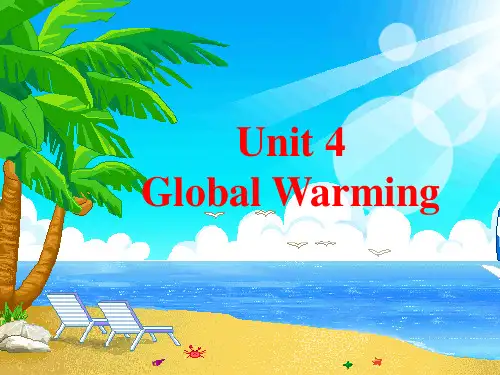
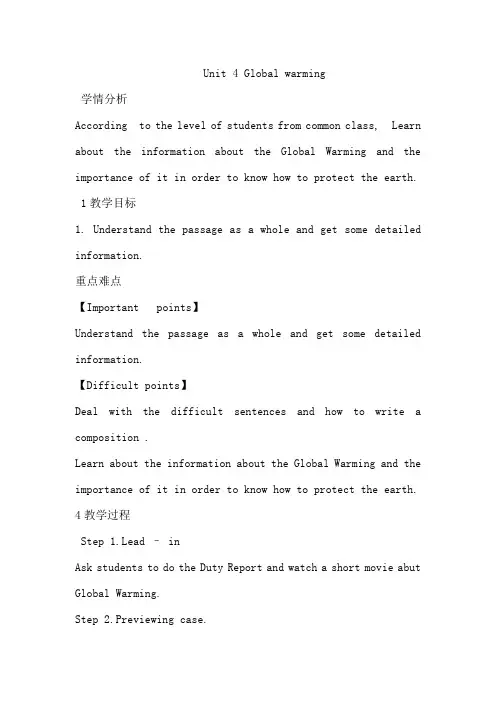
Unit 4 Global warming学情分析According to the level of students from common class, Learn about the information about the Global Warming and the importance of it in order to know how to protect the earth. 1教学目标1. Understand the passage as a whole and get some detailed information.重点难点【Important points】Understand the passage as a whole and get some detailed information.【Difficult points】Deal with the difficult sentences and how to write a composition .Learn about the information about the Global Warming and the importance of it in order to know how to protect the earth. 4教学过程Step 1.Lead – inAsk students to do the Duty Report and watch a short movie abut Global Warming.Step 2.Previewing case.Ⅰ.Revise the words and Expressions.2.Play a game: word competition.Step 3. Exploring Case :Extensive Reading :Read the passage and find the sentences structure of difficult sentences.Task 1 Fast reading :Ask some questions.1. Who are the writers and what is the purpose of writing the letters?2. What problem does OuyangGuang have?Task 2 Skimming: Try to correct the sentence .1.Ou yang Guang thinks that individuals can make a difference to improve environmental problems at first.2.Many things we do every day may result in the growth of the green house gas.ing things that was made from recycled materials will save a lot of money. Task Task 3 Scanning : Retelling :Fill in the blanks.What can we do about global warming?Ou yang Guang is doing a project on 1______of his school about global warming. He thinks individuals can have little ___ on environmental problems. Individuals can 4____ __ __and we don’t have to put up with ___5_ .They shoulddo something as follows :◆ 1 leave an_______ _____ on so long as you are using it ,if not ___ it __.◆ 2.Put on more clothes instead of turning up the _____.◆ 3. Walk or __________ instead of taking motor vehicles.◆ 4.______ cans, bottles, plastics and newspapers.◆ 5. Buy things made from _______ __________.◆ 6.Buy products that are economical with _______.◆ 7. __________ in your garden or your school yard.◆ 8.Talk with your family and friends about _____________. Task 4: Read the passage and analyze the sentences structure of difficult sentences.Step 4. practice :retell the main points of extensive reading. Step 5: Discussing and WritingWrite a persuasive poster on fighting against the global warming.Step 6. Summary .Step 7.Homework :1.Retell the main points of Extensive reading and recite the three sentences.2.Self-study: learn the language points on Ex 62-64 to do the following exercise about language points on previewing case.精美句子1、善思则能“从无字句处读书”。
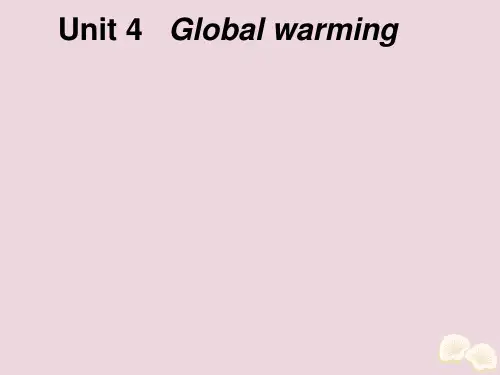
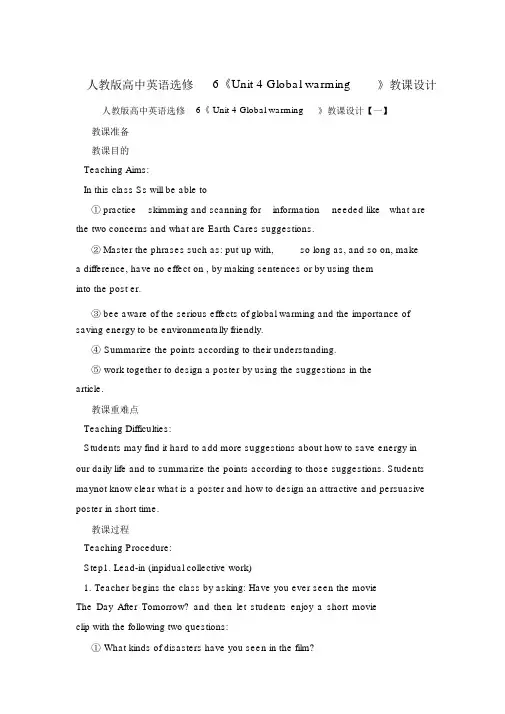
人教版高中英语选修6《Unit 4 Global warming 》教课设计人教版高中英语选修6《 Unit 4 Global warming 》教课设计【一】教课准备教课目的Teaching Aims:In this class Ss will be able to① practice skimming and scanning for information needed like what are the two concerns and what are Earth Cares suggestions.② Master the phrases such as: put up with, so long as, and so on, makea difference, have no effect on , by making sentences or by using theminto the post er.③ bee aware of the serious effects of global warming and the importance of saving energy to be environmentally friendly.④Summarize the points according to their understanding.⑤work together to design a poster by using the suggestions in thearticle.教课重难点Teaching Difficulties:Students may find it hard to add more suggestions about how to save energy in our daily life and to summarize the points according to those suggestions. Students maynot know clear what is a poster and how to design an attractive and persuasive poster in short time.教课过程Teaching Procedure:Step1. Lead-in (inpidual collective work)1.Teacher begins the class by asking: Have you ever seen the movieThe Day After Tomorrow? and then let students enjoy a short movieclip with the following two questions:①What kinds of disasters have you seen in the film?②Can you guess how they came about (happen)?2.introduce the topic:global warming. And then have a further question:①What other disaster will be caused by global warming?【 Designing Purpose 】To arouse students interest by watching the movie clip and educe thetopic, that is global warming. And then by showing a lot of pictures,make students know and understand the terrible effects of global warming, thus making preparations for promoting environmental protection.① who is the writer?② what are his two concerns?Scanning: Read the second letter and answer the following questions:①Does Earth Care agree with Ouy ang Guangs opinion thatinpiduals can have no effect?②what are Earth Cares suggestions?③Can we carry those suggestions out? Why?【Designing Purpose 】To help the students grasp the main information of the two letters by skimming and scanning. While stud ents get the answer to question1,ask them to find the supporting sentence : Together, inpiduals can makea difference. We do not have to put up with pollution. Guess themeanings of the two italicized phrases according to the surroundings andtheir understanding.Step3. Post reading (Pair work)1.Discussion: Make students discuss whether they can find moreways or suggestions about reducing carbon dioxide and saving energy inour daily life.Suggested ways:1)Use less hot water 7)Change a light bulb 8)Try car sharing2)Take a shower instead of a bath3)Buy fresh food instead of frozen4)Buy things that are actually in season5)Eat less high fat food like KFC and Macdonald6)Clean filters(过滤器) on your air conditioner.【Designing Purpose 】To cultivate students to work in pairs and learn to summarize an opinion and share the knowledge of saving energy in daily life. To practice theability of understanding the meaning of new words and expressionsto remove the obstacles in reading.Step4. learn what is a poster (collective work)Know what is a poster by giving a simple sample and try to getthe structure.【Designing Purpose 】To know clearly a poster should have a heading, contents and an eye-catching slogan, which will make it easy for students to design anacceptable poster.Step5. Prepare the poster (inpidual group work)1. Decide our content s:①Choose and decide five most important suggestions. (inpidual work)②W rite them downon your paper and try to makethem persuasive by using imperativesentences. (inpidual work)③pare your list with your group membersand decide five for your poster. (groupwork)2. Slogan and heading: showing sample posters to help them decide aheading and a slogan for your poster.【Designing Purpose 】This is the most important part of this writing task. Students willbe able to summarize and pose sentences by choosing and organizingwhat they want to say, thus improving their writing ability and the processof output based on what they have learned in reading part. And by learning some sample posters to help them decide their own heading and slogan.Step6. produce show time (group work)With the heading, slogan and ways, students will not find it difficultto make a poster. What theyShould pay attention is how to illustrate their poster and makeit more attractive. And then choose several pairs to represent their posters.【Designing Purpose 】Making the poster will improve their cognitive capability of theimportance of environmental protection and at the sametime they can enjoya sense of achievement in show time. And they make believe that inpiduals can really make a difference.课后习题Homework :Put their poster up around the school to make more students know about energy saving and global warming. Write a short passage to tell othershow to solve the problem of global warming based on the suggestionsyou have collected and send it in your zone or blog.板书板书设计: tsunami/ flood/More suggestions: make full use of paper/ use both sides ofpaper reuse waterlimit the time of using private carssend emails instead of cardsuse less hot wateralways take a shopping bag with youdrive a bicycle but not e-bicycle人教版高中英语选修6《Unit 4 Global warming 》教课设计【二】教课准备教课目的Teaching goals教课目的1. Target language目口号言a.要点词汇和短语energy, light (v.), heat (v.), renewable, non-renewable, fuel, blame, run outb.社交用语I dont think so.I dont think thats right.Im afraid you are wrong.2. Ability goals 能力目标Enable the students to talk about different sources of energy andexpress their own ideas.3. Learning ability goals 学能目标Help the students learn how to give their ideas about the use of energy.教课重难点Teaching important points 教课要点Enable the students to express agreement and disagreement.Teaching difficult points 教课难点Enable the students to learn how to express agreement and disagreement.教课过程Step ⅠRevisionT:Good morning, everyone.Ss: Good morning, teacher.T: Sit down, please. Before class, Ill check your homeworkfirst.Mary, would you read your homework to us?Check the students homework and have a discussion with the studentsabout the mistakes Mary made. Let the students have a clear understanding about the mistakes and then correct them.Step ⅡWarming upT: As we all know,we depen d on energy to do many things in our daily life. Some people even say we could do nothing without energy. Can youtell me what we use energy for?Sa: Energy lights our cities.Sb: Energy heats our buildings.Sc: Energy entertains us. With the help of electricity, people havegot a lot of fun from watching TV, playing puters and so on.Sd: There are many other electrical appliances that make our life more convenient and fortable such as washing machines, microwaves,air conditioners and so on.Se: Today energy also helps people realize many so-called dreams inthe past. For example, people can fly from one place to another by planewhich runs on energy.Sf:Its true. In fact, not only planes but also cars, ships and trains run on energy.T:Well done. All that youve just said is right. So it seems that energy plays a very important role in the modern world. Then where does all theenergy e from? Open your books and turn to page 25. Look at thepictures on this page. They may help you find out the answers.After a while.T:Whod like to tell us your answers?Sg: Wind power.Sh: Coal power.T:Right. Is there any difference between them?Si: Yes. Wind will never run out while coal is a limited source.T:Its true. As we know, an energy source is renewable when suppliesof it never run out while some supplies,such as coal, will definitelyrun out one day. Energy of this kind is called non-renewable sources.Please think of as many sources as you can and decide which energy sourceson your list are renewable and which are non-renewable.If necessary, give some words related to the pictures which might bedifficult for the students such as oil refinery,hydroelectric power and so on.The teacher should also collect as much information about differentsources of energy as possible and show it to the students in class through a puter. In this way, the students will bee more interested in this topic and their knowledge on this aspect will be enlarged.T: Fromwhat weve just talked about, it is clear that energy does a lot of good to every coin has two sides. Is there any negative effect of using energy?Sa: use too much energy which is resulting in an increase in carbonis how the global warming es about.Sb: Andmeanwhile it pollutes the environment.T: Itstrue. Many people have realized the problem. Next well do some listeningpractice on this topic. Lets see what other people think of this issue.Thestudents are asked to read the questions quickly to find out the listeningpoints first.Then listen to the tape twice and give the correct answers.T: Nowplease turn to page 31. Lets do listening. Before you listen to the tape,please read fast the statements in Exercise 1 to find out thelistening much attention to the key points while listening.Play thetape for the first time. Help the students get a generalunderstanding aboutthe dialogue. The students listen and try to finishExercise 1. Play the tapeagain, train the students ability to spot specific information and understandthe implication in the dialogue.The students listen and finish Exercise 2.Severalminutes later.T:Have you finished the exercises?Ss: Yes.T: OK,lets check your answers.Explainsome difficult points if necessary.T: Nowread what Professor Chen and Li Bin say. Work in groups. Discuss who you agreewith and give reasons. Use some of the phrases listed in Exercise 2 or anyothers you know.课后习题Homework1.Review the new words and expressions you learned in this class.2.Preview Reading.。
新授课课时教案科目:英语主备人授课时间:第周星期年月日授课教师:精美句子1、善思则能“从无字句处读书”。
读沙漠,读出了它坦荡豪放的胸怀;读太阳,读出了它普照万物的无私;读春雨,读出了它润物无声的柔情。
读大海,读出了它气势磅礴的豪情。
读石灰,读出了它粉身碎骨不变色的清白。
2、幸福幸福是“临行密密缝,意恐迟迟归”的牵挂;幸福是“春种一粒粟,秋收千颗子”的收获. 幸福是“采菊东篱下,悠然见南山”的闲适;幸福是“奇闻共欣赏,疑义相与析”的愉悦。
幸福是“随风潜入夜,润物细无声”的奉献;幸福是“夜来风雨声,花落知多少”的恬淡。
幸福是“零落成泥碾作尘,只有香如故”的圣洁。
幸福是“壮志饥餐胡虏肉,笑谈渴饮匈奴血”的豪壮。
幸福是“先天下之忧而忧,后天下之乐而乐”的胸怀。
幸福是“人生自古谁无死,留取丹心照汗青”的气节。
3、大自然的语言丰富多彩:从秋叶的飘零中,我们读出了季节的变换;从归雁的行列中,我读出了集体的力量;从冰雪的消融中,我们读出了春天的脚步;从穿石的滴水中,我们读出了坚持的可贵;从蜂蜜的浓香中,我们读出了勤劳的甜美。
4、成功与失败种子,如果害怕埋没,那它永远不能发芽。
鲜花,如果害怕凋谢,那它永远不能开放。
矿石,如果害怕焚烧(熔炉),那它永远不能成钢(炼成金子)。
蜡烛,如果害怕熄灭(燃烧),那它永远不能发光。
航船,如果害怕风浪,那它永远不能到达彼岸。
5、墙角的花,当你孤芳自赏时,天地便小了。
井底的蛙,当你自我欢唱时,视野便窄了。
笼中的鸟,当你安于供养时,自由便没了。
山中的石!当你背靠群峰时,意志就坚了。
水中的萍!当你随波逐流后,根基就没了。
空中的鸟!当你展翅蓝天中,宇宙就大了。
空中的雁!当你离开队伍时,危险就大了。
地下的煤!你燃烧自己后,贡献就大了6、朋友是什么?朋友是快乐日子里的一把吉它,尽情地为你弹奏生活的愉悦;朋友是忧伤日子里的一股春风,轻轻地为你拂去心中的愁云。
朋友是成功道路上的一位良师,热情的将你引向阳光的地带;朋友是失败苦闷中的一盏明灯,默默地为你驱赶心灵的阴霾。
Unit 4 Global warming ----ReadingI.Revisionin consequence/come about/ be opposed to/ go up/ result in/ a large quantity of1) With the use of electricity, great changes have ¬¬¬¬___________ in our life.2) The police found _____________drugs at his home.3)At first they _____________the scheme,but we managed to argue them round.4) The price of oil has _______________by over 50 percent in less than a year.5) It rained yesterday and _____________the match was canceled.6) The fierce quarrel both sides’ breaking up from each other. II.Reading tasks:1) Read the text and then match the main idea of each part.Part 1(Paragraph 1) a.List two different attitudes among scientists towardsglobal warmingPart 2(Paragraphs 2~5) b.It`s up to readers to think and decide whether people should do something about global warming or not. Part 3(Paragraph 6) c. Illustrate how global warming comes about. Part 4(Paragraph 7) d. Introduce a debate over the issue of globalwarming.2)Try to find out the main idea of the text.The ______have different ideas on whether it _______ when the earth is becoming _______.3)Read the passage and answer the following questions.1.What does the `green house effect` refer to?2.What has resulted the increase in carbon dioxide?3. Who wrote the magazine article? What is the name of the magazine?4. What are the names of the three scientists mentioned?5. Do the scientists agree with one another about the global warming?6.The different ideas between Dr. Janice Foster & George Hambley Dr. Janice Foster----Carbon dioxide has caused the global temperature to _____.An increase of five degrees would be a________and could be______.George Hambley----More carbon dioxide is a _____thing,which makes crops_______and will encourage_______.4)SummaryAll scientists 1.________ to the view that it is human activity that has caused the global warming.This activity is burning fossil fuels,to produce energy .As a result, a natural 2.__________called the“greenhouse effect” has 3.____________.Without this phenomenon,the earth would be about 4._______cooler than it is.So,we need those gases. However,the global temperature will rise when we add huge5.________of extra carbon dioxide into the atmosphere. We know that the levels of carbon dioxide have6._______ greatly over the last 100 to 150 years. The attitude of scientists towards this rise is completely7________ . Some think that the trend would be a catastrophe while some are 8.______ to this view,and they believe that any warming will be 9.____________ with few bad environmental 10.__________.eful sentences about protecting enviornment.1.Environmental protection has caused global concern recently.2.Everybody should raise the awareness that it’s our duty to protect our mother earth.3.It’s high time we took immediate measures to protect our earth from being polluted.4.On no account should we develop our economy at the cost of our environment.5.With the increase of the world population, our environment is getting worse and worseIV.HomeworkWrite a short passage using the topic about protecting environment.。
Global Warming: Whose Problem is it Anyway?It no longer seems to make a difference who started the global warming problem, and by “problem,〞I am referring to the likely enhancement of the naturally occurring greenhouse effect as a result of human activities. Those activities primarily center on the release of carbon dioxide through the burning of fossil fuels such as coal, oil and natural gas. Other heat-trapping greenhouse gases include methane, nitrous oxide and chlorofluorocarbons (CFCs).In their march to industrialization, rich countries have basically saturated the atmosphere with these heat-trapping gases. Each year, the atmospheric concentration of carbon dioxide (arguably the most important of the greenhouse gases) increases by more than a part p er million by volume. Doesn’t that sound infinitesimal? It does to me. But, infinitesimal concentrations become significant when accumulating in the atmosphere year after year, as carbon dioxide has since the onset of the Industrial Revolution in the mid-1700s.As we settle into the 21st century, new major greenhouse-gas-producing nations are appearing on the scene, such as India and China. They want to develop their economies, and they have a right, as well as a responsibility, to their citizens to do so. But they are also going to be emitting a larger share of heat-trapping gases, overtaking the industrialized countries that have been the dominant producers of greenhouse gases in the past. Now what?A couple of decades ago, I chose to divide the observers of global warming into three groups: hawks, doves and owls. In the mid-1980s, there were some hawks (those who are convinced beyond a reasonable doubt that human activities not only can, but also are, altering the chemical composition of the atmosphere in ways that influenceglobal climate); some doves (those who believe that Earth’s atmosphere is so robust that it can absorb any insult that humans might do to it. Besides, if it gets really serious, either technology will save us, or we Americans can move north into Canada); and mostly owls (those who lean either toward the hawks’ or the doves’ view, but are still not sure what the truth is).Twenty-five years later, the hawks have increased in number, while the doves are about the same with maybe a few m ore vocal personalities. And the owls’ numbers have reduced due to new scientific information — appearing in the media alongside scary photos of disintegrating ice sheets in the Antarctic and depletion of sea ice in the Arctic, stories about a seeming incr ease in various “superstorms,〞and advertisements from Shell and BP telling us that they too are worried about global warming.Since 1985, however, another category has emerged: the ostrich. The ostriches include those who refuse to think about global warming as a problem, who refuse to consider any new scientific research, and who think that someone somewhere will solve this problem before it becomes a crisis.Global warming is not a hoax. It actually happens naturally. Industrialization processes in rich countries and now in developing ones are abetting the naturally occurring greenhouse effect.Some say we are spinning out of control, pointing to the Arctic as a “canary in the global warming mine.〞The Inuit are worried. They are on the proverbial firing line, according to scientists who remind us that a 1 degree warming in the mid-latitudes will be associated with a 3 to 4 degree warming in the higher latitudes. What we are hearing from the scientists is that we are at or near tipping points — irreversible thresholds of change — for certain species, countries and civilizations.But although we talk a lot about doing something about global warming, we do not have a whole lot of meaningful action. “Let them eat carbon dioxide〞seems to be the current response of various governments, despite words of concern. Is anyone trying to cut back on carbon dioxide emissions?Cutting back on carbon dioxide production is much easier to say than to do. The task of cutting back worldwide is made much more difficult because of the virtual lack of participation of the United States as a leader on the global warming issue in the international community. It is hard to keep bailing out the water at one end of a sinking boat, while someone at the other end insists on drilling holes in the hull.The business community, at-risk cities and island nations are increasingly calling for action to combat human-induced global warming. What is needed? Only an active government policy around which a coalition can rally will thoroughly address the complex issue.Alas, the issue demands government leadership from the “bully pulpit〞that calls for and wholeheartedly supports an all-out “war on global warming.〞In my view, it is the only way to address the global warming problem with some sense of optimism.Societies need to find new and more efficient ways to fuel their growing economies. The wars on crime, prostitution, alcohol, drugs and even terror are not really winnable wars. They are not winnable in the sense that views on these issues represent underlying differences of opinion. However, the physics of the atmospheresuggests that we (civilizations) are on a collision course with Mother Nature, and if atmospheric science is correct, there is little time for delay.The war on global warming should begin now. With government support (moral and financial) and a search for new ways to keep our industries progressing withoutadding greenhouse gases to the atmosphere, there is a real chance for the global community to pull together.Technology alone, especially if it is expected to be applied only at the proverbial 11th hour, can’t save us from many of the projected and foreseeable negative impacts of global warming. For an example of thinking ahead, take the Netherlands.The Dutch have successfully fought off the floods of the North Sea for centuries, with few breaches in recent times (1953 comes to mind). The Netherlands have even contracted with the U.S. federal government for a few hundred million dollars, to assist in developing levees that can withstand certain intensities of tropical storms around New Orleans.Despite their levee-making skills, however, the Dutch know their limits. The Netherlands is now working to develop a “Hydropole,〞a city that can live on the rising waters. They know they need to do something to protect the 70 percent of the country that is below sea level, when a warmer atmosphere leads to rising seas.Other countries need to follow by accepting the potential changes that lie ahead, and working now to plan for those changes and to curb actions that would otherwise fuel more change. Only with an aggressive war on global warming, supported by the entire international community of nations and with participation of the United States, can we learn to live within the guidelines of nature, respecting her thresholds of change by choosing not to cross them.。
高中英语选修六unit4 global warming要点解析随着工业化、城市化的发展,人类对环境的破坏日益严重,全球变暖成为一个备受关注的问题。
在高中英语选修六的教学中,unit4 global warming是一个重要的话题,涉及到了环境保护、气候变化、能源利用等多个方面。
本文将从以下几个方面进行解析。
一、词汇与短语在学习unit4 global warming的过程中,学生需要掌握一些与环境保护、气候变化、能源利用等相关的词汇和短语,例如:1. global warming:全球变暖2. climate change:气候变化3. greenhouse gases:温室气体4. carbon dioxide:二氧化碳5. fossil fuels:化石燃料6. renewable energy:可再生能源7. solar power:太阳能8. wind power:风能9. hydroelectric power:水力发电10. deforestation:森林砍伐二、文章结构在学习unit4 global warming的文章时,学生需要掌握文章的结构,了解作者的写作意图和思路。
一般来说,文章的结构包括开头、主体和结尾三个部分。
1. 开头:一般用一两句话引出话题,概括文章主要内容,引起读者的兴趣。
2. 主体:主要分为两个部分,第一部分阐述全球变暖的原因和影响,第二部分介绍如何减缓全球变暖的措施。
3. 结尾:一般用一两句话总结文章内容,表达作者的态度和观点。
三、文章内容在学习unit4 global warming的文章内容时,学生需要掌握以下几个方面。
1. 全球变暖的原因:全球变暖的主要原因是温室气体的排放,其中二氧化碳是最主要的温室气体。
二氧化碳的排放主要来自于化石燃料的燃烧、工业生产、交通运输等活动。
2. 全球变暖的影响:全球变暖会导致海平面上升、极端天气增多、生物多样性减少等问题,对人类和自然环境都会带来严重的影响。
Book6 Unit4 Global warming 导学案(Period One: Reading)课前案Skim the text and finish the following information.1.What’s the main topic of the passage?The main topic of the passage is about .2.Who wrote the magazine article? What is the name of the magazine?wrote the magazine article; the name of the magazine is .3.What are the names of the three scientists mentioned in the article?The names of the three scientists mentioned in the article are , , and .Do they agree with one another? .4.The passage can be divided into three sections, match them with the main idea of each section.Part1.(1) A. How global warming comes aboutPart2. (2-5) B. List two different attitudes towards global warmingPart3. (6) C. Introduction of global warmingPart4. (7) D. Whether people should do something about global warming课中案学习目标:1.To learn some important words and phrases about global warming.2.To develop the reading skills by skimming and scanning the passage.3.To strengthen the awareness of environment protection .Step 1 Fast readingRead the text quickly and choose the best answers.1. How much did the temperature rise in the 1900s?A.One degree Fahrenheit. B.One Celsius.C.Two degrees. D.Thirty degrees Celsius.2.What causes the earth’s temperature increasing?A. Cutting treesB. Wasting the farmland.C. Running out of the river waterD. Burning fossil fuels.3.Which of the following is Dr. Janice F oster’s opinion?A. The result of the temperature increase will be serious.B. The amount of warming is nothing serious.C. We needn’t worry about high levels of carbon dioxide.D. Global warming is a natural phenomenon.4.According to George Hambley, .A. Global warming is a serious problem.B. There is no need to worry about global warming.C. The levels of CO2 in the air will become lower in the future.D. More animals will make greenhouse gases decrease.5. We can infer from the text that __________.A. the debate about the effects of global warming has not been settled.B. the greenhouse effect is the result of people’s actions.C. all scientists think it is important to reduce the amount of CO2 in the atmosphere.D. reducing greenhouse gases will immediately decrease the earth’s temperature.Step2 Careful reading Read Para.2 to Para.6 and fill in the blanks.(Para.2-Para.3)The reasons for global warming(Para.4-Para.5)The levels of carbon dioxide have increased greatly over the last . According to Dr.Charles Keeling, from to , the amount in the atmosphere went up from around parts to around parts per millionDr.Janice Foster believes over the next century ,the amount of warming could be as lowas degrees Celsius, but it could also be as high as degrees.(Para.6)Step3 Further reading True or False()1.The temperature in the last century seemed to increase much.()2. Everyone believes that global warming is caused by the activities of humans.()3. The rise in carbon dioxide is causing a steady increase in global warming.()4. George Hambley believes that global warming will do good rather than harm to the earth. ()5. It is clear what the effects of global warming will be.Step 4 Fill in the blanks to retell the passage.The temperature of the earth 1 (rise) about one degree during the 20th century. How has this come 2 ? All scientists subscribe 3 the view that it is human activity 4 has caused the 5 (globe) warming rather 6 a random but natural phenomenon. Some scientists think we add large 7 (quantity) of carbon dioxide to the air. Some scientists believe the burning of more and more fossil fuels 8 (have) resulted in the increase of carbon dioxide. Greenhouse gases continue to build 9 . It may be a catastrophe but George 10 (state) that it is a positive thing.Step 5 Free talk — a short speech 能力提升Between the two opinions ,decide on one to have a discussion in you group and then choose a speaker to give a speech on behalf of your group. The following information may help you.课后案I.课外延伸阅读Further reading about global WarmingGlobal warming is the unusually rapid increase in Earth’s average surface temperature over the past century primarily due to the greenhouse gases released as people burn fossil fuels. The global average surface temperature rose 0.6 to 0.9 degrees Celsius (1.1 to 1.6° F) between 1906 and 2005, and the rate of temperature increase has nearly doubled in the last 50 years. Temperatures are certain to go up further.Earth’s natural greenhouse effect Earth’s tempe rature begins with the Sun. Roughly 30 percent of incoming sunlight is reflected back into space by bright surfaces like clouds and ice. Of the remaining 70 percent, most is absorbed by the land and ocean, and the rest is absorbed by the atmosphere. The absorbed solar energy heats our planet. As the rocks, the air, and the seas warm, they radiate “heat” energy (thermal infrared radiation). From the surface, this energy travels into the atmosphere where much of it is absorbed by water vapor and long-lived greenhouse gases such as carbon dioxide and methane. When they absorb the energy radiating from Earth’s surface, microscopic water or greenhouse gas molecules turn into tiny heaters— like the bricks in a fireplace, they radiate heat even after the fire goes out. They radiate in all directions. The energy that radiates back toward Earth heats both the lower atmosphere and the surface, enhancing the heating they get from direct sunlight. This absorption and radiation of heat by the atmosphere—the natural greenhouse effect—is beneficial for life on Earth. If there were no greenhouse effect, the Earth’s average surface temperature would be a very chilly -18°C (0°F) instead of the comfortable 15°C (59°F) that it is today.What has scientists concerned now is that over the past 250 years, humans have been artificially raising the concentration of greenhouse gases in the atmosphere at an ever-increasing rate, mostly by burning fossil fuels, but also from cutting down carbon-absorbing forests. Since the Industrial Revolution began in about 1750, carbon dioxide levels have increased nearly 38 percent as of 2009 and methane levels have increased 148 percent.II.拓展提高书面表达如何解决全球变暖是我们全人类共同面临的一个难题。